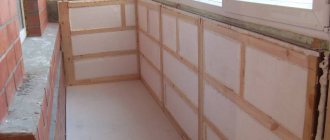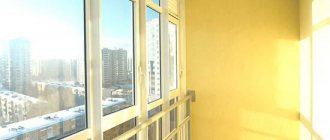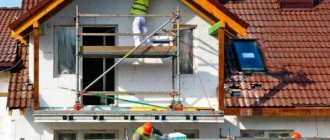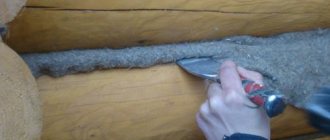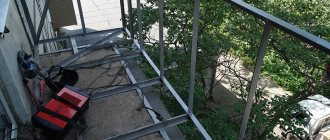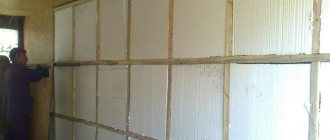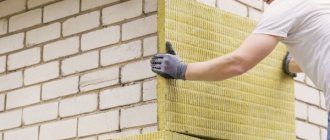Insulating a balcony from the outside is a rather complicated task, but important, as it helps to increase the thermal insulation properties of the glazed structure, which can serve as a natural buffer. As a result, the apartment will be much warmer. If the balcony is located at a height accessible from the ground, you can insulate it yourself; if it is higher, you will need to hire specialists with special climbing equipment.
Why do you need insulation?
Insulating the loggia from the outside only makes sense if the structure is glazed. Despite the fact that the balcony area is small, it has a serious impact on the temperature in the living room. If the balcony or loggia has good insulation, then the heat from the apartment will not leave the room, and on the loggia itself you can arrange a comfortable corner for a pleasant pastime, since it will also be quite warm.
Glazing helps make the room warmer, especially if a sealed, warm option is used, but heated air can penetrate into the street, and the cold from outside will enter the balcony through the walls. Insulating the balcony from the outside helps to avoid these problems and reliably isolate the room from the external environment.
Advice from professionals
To save money, you can do some of the work yourself. So, decorating the inside of the loggia with your own hands is accessible to any adult
Please note important points:
- Protect insulation and frame elements from moisture. Install a vapor barrier membrane from the inside with taped seams. From the outside, protect the balcony from atmospheric moisture. Do not neglect the window sills, they will allow you to divert rain from the parapet.
- Polyurethane foam is destroyed by exposure to UV radiation. Protect foam seams with sealants or decorative caps.
Insulating the loggia will increase the size of the usable area of the apartment and increase its climatic comfort.
Where should I start?
Even if you have already bought a home with a glazed balcony, you should carefully study its design. It is quite possible that the windows are not too thick or the insulation is not done, in which case it will be uncomfortable on the balcony in winter, even if heating is installed there. That is why it is worth starting work by replacing double-glazed windows with thicker and warmer ones and insulating the structure from the inside and outside. It is necessary to ensure that all joints and cracks are properly insulated, which will help get rid of drafts.
It is quite possible to insulate a balcony from the outside with your own hands, but this is quite dangerous if the balcony is at a high altitude. It will be much easier for residents of the first two floors to do the work. In any case, the principle of laying insulation is the same.
First of all, you should choose the material that will be used as insulation for the balcony. For indoor and outdoor use, different types of material are usually used, or you will have to cover the balcony with something to protect the insulation and give it an attractive appearance. It is worth noting that additional finishing will not hurt in any case. External insulation is good because it does not reduce the internal space of the room, so you can use insulation of any thickness.
Preparatory stage of work
Before starting work on insulating the parapet of a balcony (loggia) from the outside with your own hands, it is necessary to assess the volume of work to be done, the condition of the material from which the parapet is made, and calculate the cost of the work, taking into account the involvement of industrial climbers or the rental of special equipment. If the calculations received do not scare you and we are not talking about the price or the time spent on obtaining permission from regulatory authorities to make changes to the design and appearance of the building’s façade – then let’s get to work!
We have already written in an article devoted to do-it-yourself insulation of balconies in Khrushchev-era apartment buildings, about the difficulties in obtaining permission to carry out work associated with making changes to the external enclosing structure of a small balcony and the facade of the building. In addition to the lack of regulatory documents in Russian legislation that would provide for such a possibility and would make such insulation legal, it will also be necessary to coordinate the work with the owners of the apartment building, since the external walls and structures are the joint property of all owners of the apartment building.
Unauthorized changes entail not only dissatisfaction with neighbors, but the obligation to restore the façade structures to their previous form at your own expense. If you managed to obtain the necessary permits, then you can begin to carry out work.
What is dew point?
Before insulating a balcony from the outside, you need to take into account such a physical quantity as the dew point. This is an indicator of the temperature at which condensation begins to appear.
Dew point when insulating a balcony from the outside
In order to subtract a point, you need knowledge of what atmospheric pressure, relative humidity and temperature are. Knowing the dew point, you can find out at what temperature condensation is most likely to appear on glass or elsewhere. If you insulate a structure from the outside, the calculation point will be located outside, that is, condensation will settle on the outside of the balcony, due to which the humidity inside the structure will not increase.
To choose a sufficiently reliable insulation, you need to know the approximate dew point in the most severe frost that occurs in your locality. If this factor is not taken into account and internal insulation is made, during which the insulation will freeze, after which the walls will become wet. Because of this, fungus and mold will appear on them over time. If the balcony is insulated from the outside , the cold first encounters the insulation, then the wall, so condensation will not appear between it and the wall material.
Where are gas blocks used?
The properties of aerated concrete and construction technology provide for the possibility of using porous building materials for the following purposes:
When building a private house, you can do without lifting mechanisms, and the pace of construction increases
- construction of load-bearing walls and interior partitions. Aerated concrete products of grade D 500 are used, capable of withstanding significant forces;
- thermal insulation of brick and reinforced concrete walls on the facade of the building. Use material marked D300, D400 or D500;
- construction of fences. Such structures can be quickly erected and do not require large expenses;
- construction of a reinforced belt around the perimeter of the walls. U-shaped aerated concrete products reinforced with reinforcement are used;
- production of monolithic lintels for various openings. Profile products made of aerated concrete are used.
Increased thermal insulation, overall dimensions and high frost resistance make it possible to use aerated concrete blocks for the construction of residential buildings, the construction of garages and the construction of bathhouses. The material is popular due to its reliability and durability. However, block walls need waterproofing protection. The safety factor ensures the ability to build houses from aerated blocks three floors high.
Which insulation to choose?
For external insulation, you can use the same material that is proposed for internal insulation. However, some types of insulation are afraid of moisture, while others are not.
- Mineral wool is a popular, relatively inexpensive insulation material that can retain heat well, but it requires reliable waterproofing. Wet wool will lose its properties, fungus may appear in it or insects may appear in it, so it is important to immediately make a hydro- and vapor barrier, cover the facade and the wool with a material that does not allow moisture to pass through. Mineral wool is not very convenient to work with. This is a soft material that tears easily, does not hold its shape, and therefore requires reliable lathing. It is worth noting that you need to use a mask, goggles and protective gloves, since cotton wool fibers strongly irritate the skin and mucous membranes.
- Foam plastic, penoflex, etc. - these are similar materials that can be classified into the same group. They are made from artificial fibers and are available in sheet form. Polystyrene foam is quite durable, does not crumble, insulates heat well and does not allow air to pass through at all, so it can be used without a vapor barrier. The material is easy to attach; no protective equipment is required. It is not afraid of water, but is quite fragile and cannot withstand strong mechanical stress. Birds love to eat it, even though it is not edible. That is why the sheets should be covered with cladding, like the previous option.
- Polyurethane foam can also be used as insulation. It fills all the cracks well, sticks to almost any surface, quickly gains volume and hardens, becoming hard. However, such insulation is destroyed under the influence of ultraviolet radiation, does not react well to moisture, turns yellow over time, and loses its properties if it is not protected with a solid material that does not allow moisture and light to pass through. Siding is good for finishing.
The problem of choosing materials
Insulation of a loggia involves the use of high-quality insulators of both rolled and extruded types. These include penofol, polystyrene foam, penoplex. Quite often several materials are used simultaneously. In this case, disputes often arise about what is better, regular polystyrene foam or polystyrene foam?
By and large, the materials are almost equivalent to each other. The difference lies in the technology of work. For example, ordinary polystyrene foam is characterized by greater vapor permeability. The difference lies in the thickness: for penoplex it can be smaller, which in some way saves usable space in the room.
In terms of service life, foam plastic retains its performance characteristics for 80 years or longer, and penoplex can function for up to 160 years. Finally, loggias insulated with penoplex have a greater property of self-extinguishing in case of fire.
How to choose exterior finishing?
When choosing what to cover the outside of a balcony with, many apartment owners primarily consider that the material should be as cheap as possible. At the same time, it must look good, protect the insulation, and be sufficiently reliable and durable. We offer several options available to suit your budget:
- Vinyl or metal siding is an affordable and easy-to-install material; it is made of steel. It can be galvanized or covered with vinyl, which protects the sheets well from scratches and rust. The material is relatively lightweight, installation does not take much time, and the siding will last for decades.
- Lining. If treated correctly, the board will not be afraid of moisture and parasites, but it will have to be processed at least once a year, which incurs additional costs. The view from the balcony will be original, but the material is more suitable for a log house than for an apartment.
- Polycarbonate. This is a durable and flexible material, does not allow air and moisture to pass through, is light in weight, can be transparent or dense, can be painted in different colors, and fits well with modern room designs. No shortcomings could be found.
Strengthening the parapet structure
The balcony parapet can be:
- Metal - from corrugated sheets, rods, metal strips, pipes - in old houses.
- From reinforced concrete slabs of “light” concrete - in panel houses starting from series 121.
- Made of brick - in most modern brick or monolithic-frame residential buildings.
The material from which the parapet is made plays a significant role in the choice of not only the insulation material, but also its thickness and installation methods.
If the balcony parapet is made of corrugated sheeting or metal welded structures, preliminary cladding of this metal structure from the side of the balcony (loggia) will be required - otherwise the metal “ribs” of the corrugated board will spoil the entire appearance of the insulated balcony and will serve as “bridges” of cold that will negate all your efforts.
In addition to installing an internal screen that will hide the metal structures (made of chipboard, plasterboard, PVC siding, plywood), it will be necessary to create a layer of insulation that would completely hide the elements of the metal structures, otherwise in winter they will freeze and the cost of heating the balcony ( loggias) will be excessive.
If the parapet is made of reinforced concrete slabs or bricks, everything is much simpler - no additional work will be required to change the design of the parapet.
How to insulate a balcony with your own hands?
How to properly insulate a balcony from the outside yourself? In fact, the answer to this question is quite simple - you need to follow the instructions:
- First you need to mount the guide profiles. Instead, you can use wooden beams, but the profile is lighter and easier to attach.
- After this, the material is mounted on the walls. The panels are cut in advance and can be sawed using a hacksaw.
- The easiest way to install foam or similar solid sheet materials. You can do this with glue, but since it is usually quite difficult to mix, it is better to use ready-made liquid nails that do not have to be mixed with water. This material sets instantly, but will cost more.
- You need to start gluing the panels from the bottom corner of the balcony structure. Make sure that it fits tightly to the bar or profile: the smaller the gaps, the better. The material must be aligned with the facade.
- After this, the sheets are laid below, then above; This is how all the external insulation of the balcony is gradually glued.
- When working with polystyrene foam, keep in mind that it can crumble. If there is a strong gust of wind, the sheet may break. If you fix it with special plastic dowels, do not fix it close to the edges.
- You need to drill holes in the timber for the plastic fasteners. You should not do this close to the frame, otherwise there is a risk of damaging it or breaking the tightness of the structure.
- The façade panels are fixed where they touch the wooden beam. If the structure is not the smoothest and the insulation cannot be applied tightly, you will need to pave the joints with construction foam.
- After the insulation is fixed in its proper place, you can begin finishing the exterior of the balcony. For this you can use, for example, siding or corrugated sheets. It is quite easy to secure them either with self-tapping screws or using special fasteners. It is much more difficult to prime the surface if some other finishing cannot be done.
- If you need to plaster a balcony, you first need to install a fiberglass mesh; it is attached using a special adhesive. The mesh is needed so that the solution sets better and does not crumble.
- Insulating the balcony from the street allows for further plastering, but work can only be carried out in dry weather. Rain can damage undried plaster. The work itself is carried out in several stages, since it is necessary to apply several layers of plaster, and each subsequent one can be applied only after the previous one has dried.
- The last layer must be leveled so that the balcony looks even. That is why it is worth installing beacons in advance, which will hide the flaws of the facade, if any.
When deciding how to insulate a balcony from the outside, it is not necessary to choose the most expensive materials, but it is worth paying attention to their quality and ease of installation and characteristics. In most cases, the work can be done independently without the involvement of installers and the use of complex equipment.
The key to a warm balcony is an insulated ceiling and heated floor.
In addition, we recommend watching a video that will show in detail the intricacies of the work.
Sequence of actions for the dry method
Stages of work on installing ventilated insulation:
- sealing cracks;
- wall preparation;
- fastening mineral wool (plastic dowels are used) in several layers and windproof film;
- installation of sheathing with a gap between it and the wall;
- installation of the outer layer.
A more economical option is to attach the sheathing to the wall, stick insulation between its ribs and reinforce it with windproof film.
It is necessary to insulate the loggia in this way if it is constantly used, including in winter. In other situations, other methods will be suitable.
Required Tools
For plastering work, you will need brushes or glue sprayers, levels, spatulas for plaster, and containers for diluting solutions. It's inexpensive compared to the materials.
The dry method requires a larger variety of tools - for installing the sheathing and fastening the insulation. Specialists have their own sets of tools, and the owner does not have to purchase them in addition.
The outer wall of a balcony can be insulated in several ways. Any of these require a work permit. To fully solve the problem of a cold balcony, you need to combine these technologies with insulating the floor and ceiling of the loggia with mineral wool.
Insulate from the outside or from the inside?
If you insulate the balcony from the inside, the reinforced concrete fencing slab will remain cold.
Builders recommend external insulation of the balcony for several reasons:
- Internal thermal insulation will take away the useful space of the balcony. Some materials are installed in two layers for greater efficiency. If we consider that in average apartments the loggia area is only 2-6 sq.m., then thermal insulation 15 cm thick will make it even more cramped.
- Dew point offset. Indoor air is usually more saturated with water vapor than outdoor air. Moisture can penetrate even through brick and reinforced concrete, so it will definitely migrate to the street. With external insulation, the wall remains warm and water vapor leaves it safely. If you insulate the balcony from the inside, the reinforced concrete fencing slab will remain cold. Moisture coming into contact with such a surface will condense and cause premature destruction of building structures.
Errors in internal insulation manifest themselves in the form of wet spots on the walls, destruction of brickwork, rotting of wooden elements and rust on metal fasteners.
Unfortunately, installation of external thermal insulation is not always possible in practice. If the residents of the first floor with an insulated balcony can still do something, then the owners of adjacent balconies on the upper floors do not have such a chance; they have to insulate from the inside.
Vapor barrier and waterproofing of balcony roof
The process of insulating a balcony roof is actually not far from the thermal insulation of a full roof. And here it is also important to protect the insulation from accidental leaks from above and steam from below. Of course, it all depends on what kind of material is used.
For example, penofol has hydro- and vapor barrier shells. But mineral wool needs to be protected on both sides, and polystyrene foam can only be installed on top, installing only waterproofing:
As we have already said, if you nevertheless chose mineral wool, then you will additionally need to secure a vapor barrier from the inside of the balcony, and a waterproofing film from the side of the roofing:
Take all the insulating films for protecting the thermal insulation of a balcony roof the same as for arranging a regular roof of a house, but only the highest quality ones - the conditions are special.
Double-sided insulation
Sometimes it is necessary to insulate a loggia on both sides, for example, on parapets. The problem is that it is not always possible to make a normal insulating layer on the outside - it is too labor-intensive. Basically, double insulation for a loggia is used when they want to create a layer of the required thickness without losing the usable space of the room.
It is not so important whether the insulating layer is continuous or interrupted in thickness. The main thing is that there is a vapor barrier layer on the inside. Savings in loggia area can be calculated based on the fact that the insulation of the partition and concrete slab is 5 cm, and the insulation of the outer part is 10 cm
Savings in loggia area can be calculated based on the fact that the insulation of the partition and concrete slab is 5 cm, and the insulation of the outer part is 10 cm.
The technology for insulating a loggia as an insulator involves both foam plastic and slabs made of stone wool. The thickness of such products is 5 cm. The products are mounted in the frame of the extension, which, in turn, is packed along the parapet. Next, the insulation is protected by a vapor barrier and sheathed with finishing material.
Thermal protection of concrete floor
To properly insulate a concrete floor, you can use joist installation. At the beginning of the process, waterproofing is installed, and the logs are placed directly on it. An insulator is laid between the frame elements, and a vapor barrier is placed on top of it. At the very end, cladding is performed.
So, the instructions for insulating a loggia include the following processes: installation of a window unit, preparation, installation of thermal insulators and finishing. The last step is to introduce a heating source and lighting fixtures.
The simplest insulation of balconies and loggias converted into living rooms is the installation of a heating device powered by electricity. But it is not economical. It is much more expedient to use, for example, a heated floor system.
The only case where it is not recommended to install an additional thermal insulation system on the floor is heating mats.
If there is insulation, the solution covering the products has every chance of cracking.
